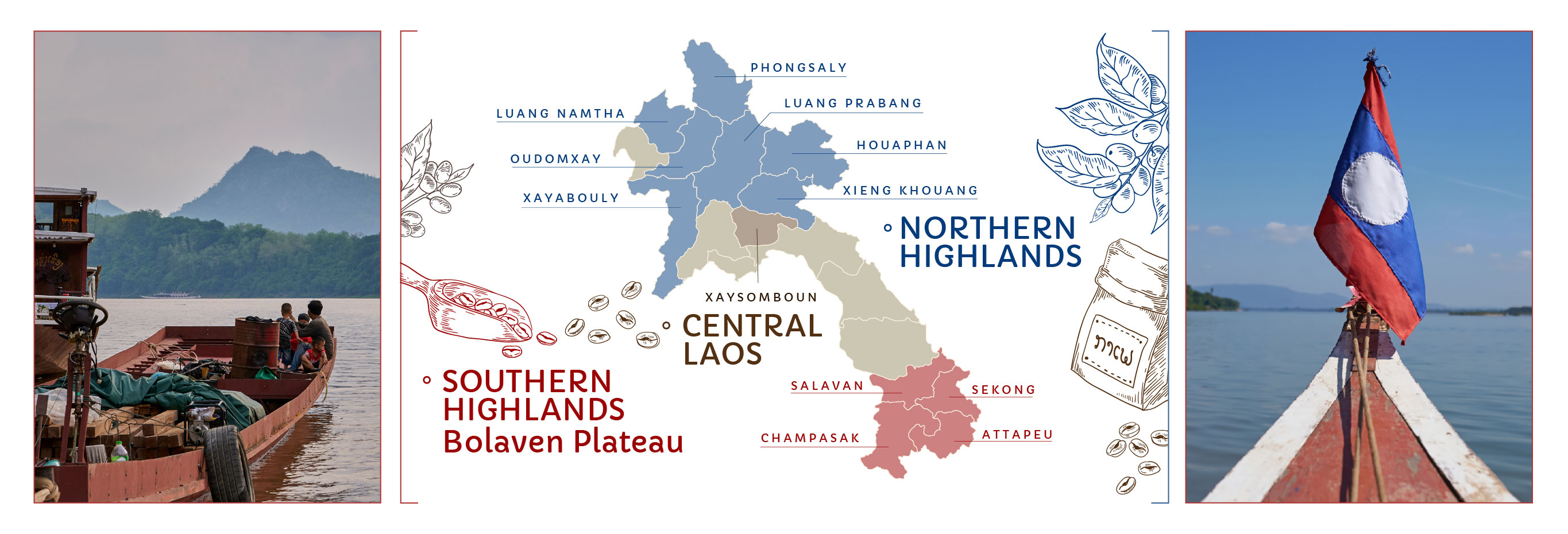Coffee in Luang Prabang Province
Luang Prabang is steadily establishing itself as a key coffee-producing region, combining tradition, quality, and innovation to support Laos’ economic development.
Luang Prabang has a tropical wet and dry climate, with distinct wet (April to October) and dry (November to March) seasons. Average annual rainfall is 1,450 mm. The cooler months of December and January bring a pleasant change to the otherwise warm, humid climate.
The high altitudes are ideal for coffee cultivation. Luang Prabang Arabica has flavors of chestnut, cocoa powder, roasted peanuts, brown sugar, and wheat. Coffee is hand-picked, processed, hulled, graded, and hand-sorted, with ethnic communities such as the Khmu, Hmong, Mien, and Gasak playing a key role in production.
Luang Prabang’s capital is an UNESCO World Heritage city, with beautifully preserved temples, French colonial architecture, and the Mekong River weaving through it.
Efforts are underway to expand coffee cultivation and improve farming practices in Luang Prabang, creating significant economic opportunities. These initiatives help preserve the region’s cultural and environmental heritage while boosting Laos’ growing coffee industry.
Well-connected by air, road, and rail, Luang Prabang also has an international airport linking to Vientiane, Pakse, Bangkok, Chiang Mai, Hanoi, and Siem Reap through Lao Airlines, Thai AirAsia, and Vietnam Airlines.
Route 13 connects Luang Prabang to Vientiane (340 km), Oudomxay, and Luang Namtha. The Laos-China Railway also offers fast train services to Vientiane and China.
Saffron Coffee, a key Arabica producer in Luang Prabang, partners with over 800 Hmong and Khmu farming families across 30+ villages.
Case Study – Saffron Coffee
In Luang Prabang, Saffron Coffee’s cafe is a popular spot for coffee sourced from Hmong and Khmu farmers. Photo by Nicole Motteux
Saffron has distributed more than 300,000 free coffee seedlings to its farmers, and provides training in crop care, organic methods, and nursery setup. Farmers are guaranteed above-market prices for their ripe coffee cherries, ensuring stable incomes.
Their coffee is shade-grown at high altitudes, hand-picked, and locally roasted in Luang Prabang for quality control. Saffron sells its coffee at its own cafe, as well as locally, targeting premium markets.
95% of profits are re-invested to support coffee farming in northern Laos, helping to lift farmers out of poverty.
Coffee initiatives in Luang Prabang province
Wat Xieng Thong temple in Luang Prabang
Coffee-Japan Project
The Coffee-Japan Project, funded by the Japanese Government, supports 300 smallholder farmers in Arabica cultivation across eight villages in Phonxay and Viengkham districts. Farmers are trained by the Japanese organisation, Saka no Tochu, in cultivation and processing techniques. An infrastructure investment also improves production efficiency.
The project aims to help improve coffee cultivation and enhance the quality of life for entire villages.
The Coffee-Japan Project emphasises support, collaboration, and strong connections. It works closely with Saka no Tochu and Saffron Coffee to access the Japanese market, establishing partnerships with Japanese companies to strengthen trade opportunities.
By targeting small and medium roasters, the initiative seeks to expand coffee exports while maintaining a strong focus on quality, ensuring that export-grade coffee meets the high standards expected by Japanese buyers.
Wonders International
The South Korean NGO, Wonders International, has supported sustainable coffee farming in northern Laos since 2019. Funded by the Korea International Cooperation Agency, the initiative provides coffee seedlings, farming equipment, and pest control tools to low-income farmers.
Farmers grow high-quality coffee on hillsides above 800 m, benefiting from fair bean prices and access to larger markets. The initiative also plans to establish farmer groups, offer management training, and build processing facilities.
Wonders International aims to support farmers in five villages to harvest coffee, generate income, and reduce slash-and-burn farming practices.
Origin Highlights
UNESCO World Heritage Site
The ancient city of Luang Prabang sits at the confluence of the Mekong and Nam Khan rivers, surrounded by limestone hills, mountains, and tropical forests.
Known for its beautifully preserved blend of traditional Lao and French colonial architecture, the UNESCO World Heritage site is also home to many Buddhist temples and saffron-robed monks. From the top of the revered Mount Phousi are panoramic views of the city, rivers and hills.
The region is defined by lush mountains, the mighty Mekong River, and serene rural villages. Visitors can explore Kuang Si Falls, a multi-tiered turquoise waterfall surrounded by dense forest. The Pak Ou Caves, nestled along limestone cliffs, house hundreds of ancient Buddha statues. Trekking opportunities abound in the scenic countryside, passing through ethnic minority villages.
The Nam Ou River provides stunning views and boat trips. Phou Khoun and Nong Khiaw are picturesque towns for nature enthusiasts seeking tranquil retreats and unforgettable views of Laos’ rural beauty.
The Nam Ou River weaves through lush green valleys near Nong_Khiaw










